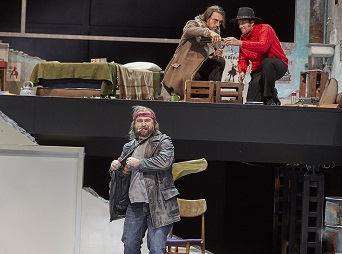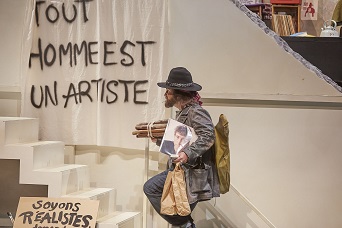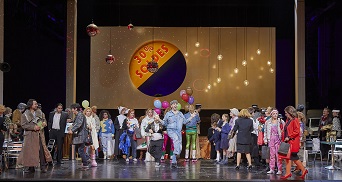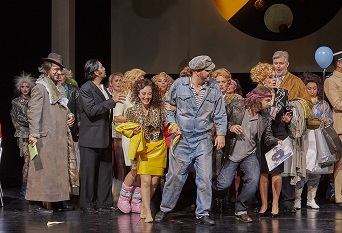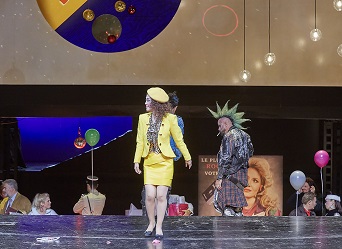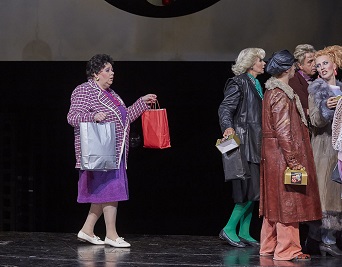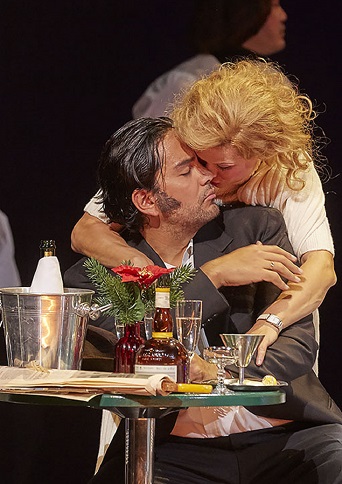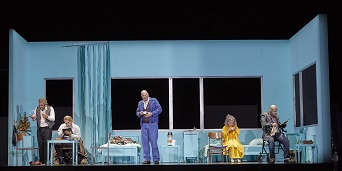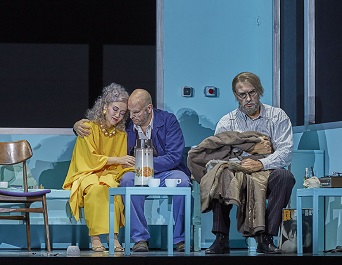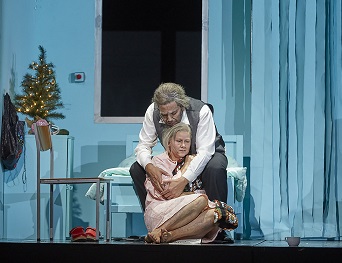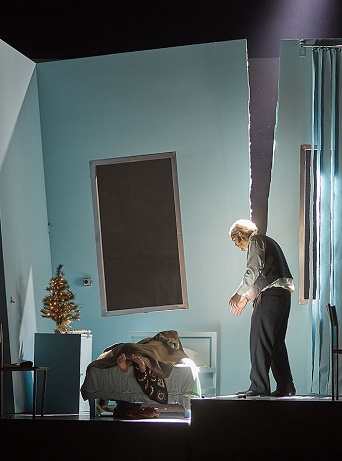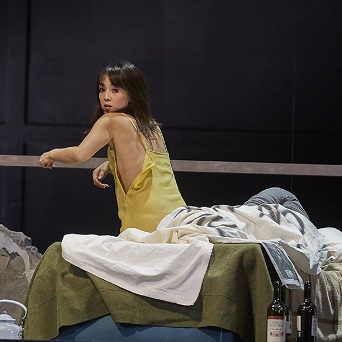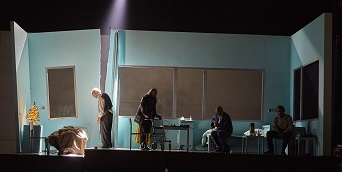2018, October 13th
La Boheme by Giacomo Puccini
in Italian with German surtitles
Premiere for the opening of the 2018/19 season for the
Mainfranken Theatre Würzburg on 13th of October 2018 at 7.30 p.m.
Musical direction: GMD Enrico Calesso
Director: Martina Veh
Stage: Emilie Delanne
Costumes: Magali Gerberon
Lighting: Roger Vanoni
Dramaturgy: Berthold Warnecke
Philharmonic Orchestra Würzburg, Opera Choir, Extra Choir (Conductor: Anton Tremmel) and Statisterie of the Mainfranken Theater
With: Silke Evers, Daniel Fiolka, Tobias Germeshausen, Mathew Habib, David Hieronimi, Roberto Ortiz, Kosma Ranuer, Igor Tsarkov, Akiho Tsujii, Taiyu Uchiyama
"Life is,
where you've been stuck
while you waited for your dreams to come true."
Uma Thurman in the film "Mad Dog and Glory".
We're crafting a life model: relationship, and if so, how? - To each his own relationship box - Of lasting decisions and emotional stamina - Relationship as an emotional risk factor - Waiting for the right one, but completely relaxed - The emotional balance in the low emotional range and what happens when you lose your balance - Should that be all? - "Concrete bird practice" versus "emancipated forms of intercourse": Of exhaustion after the constant relationship struggle - The erotic-sexual shell begins to crumble: Canceling the subscription to eternal youth
Reinhard Mohr
The bohemians who are the subject of this book are not a gender of today, they have existed at all times and in all countries, and they can lay claim to illustrious origins. So, for the anxious reader, for the timid citizen, for all those who can never find too many dots on the i of a definition, let us repeat in the form of the theorem: "Bohemia is the prelude to the artist's life, it is the prelude to the academy, the hospital or the morgue."
Let's move on to the real bohemia, the one that is partly the subject of this book. Those who belong to it are those who are truly called to art, and they have the prospect of becoming its chosen ones. This bohemia stares as well as the others from danger; for two abysses border it on either side: misery and doubt. But between these two abysses there is at least one path that leads to the goal; and the bohemians can grasp it with their eyes long before they can grasp it with their hands ...
Henri Murger
My production does not cover a few days, nor 20-30 years as in Murger's original (with a lower life expectancy at the time), but about 40-50 years, from 1968 to the 2010s. Time passes between the acts. In macro-video shots, our protagonists age between the files. The building, from squatters to a shopping centre to real estate speculators of the 90s to a home for the elderly, changes. The protagonists stay, grow old in their neighbourhood. Mimi dies. In the old people's home.
What moved Puccini?
It was not without reason that Puccini and his librettists Luigi Illica and Giuseppe Giacosa gave a lot of thought to the time in which they wanted their opera La Bohème to be set: shortly after 1830. The July Revolution in Paris, it meant the renewed seizure of power by the bourgeoisie in a liberal kingdom against the attempts of Charles X to restore the power of the nobility in the old sense. Students, workers, craftsmen rose up and forced the king to abdicate. For the first time, this was a movement of citizens, which then spread to several countries, culminating in the March Revolution of 1848/49 in Germany
Puccini, and also Henri Murger in his novel, were certainly not solely interested in the private fates of the student body; there was more at stake. The novel covers a period of about 20 years in its flashy short and serial stories in which the characters move. The scenes from the life of the bohemians are about both the attempt to reorganise society and the criticism of existing conditions, as well as the question of the attitude and consistency of the students of the time, who move between their concept of life or their professional image and the necessities of everyday life. There is a latent criticism of the "intelligentsia", an intellectual layer without a bottom, surrounded by capitalist admirers, but whose substance is questioned again and again.
It is the small things, Puccini says elsewhere, that interest him. With La Bohème he has created a modern work, as close to reality as a well-done serial story. For he also cuts cinematically into emotional extreme situations in his libretto in four pictures: What will become of the life plans of the young rebellious generation? What will become of love? Habit? Little by little, the protagonists lose their ability to love. From the 3rd picture at the latest - which caused him and his librettists headaches until the very end - all the characters live more and more in recollection and mourn their youth. What does unconditionality mean? What conditions have to be right, what way of life results from it over the years? What compromises do I make and what do they cost me? Perhaps loneliness? And what do these compromises cost the society you dreamed of changing?
All this sounds very familiar to us today when we look at the 1968 generation in retrospect from 50 years ago. From this observation, in turn, astonishing parallels to Puccini's musical/scenic structure emerge. His generation, too, found political divisions in their countries - just like the young people of the 1830s in France before them. This also applies to the world of Puccini the composer: his generation criticised Verdi's generation, just as since the 1910s the so-called "Generazione dell'ottanta", the generation of the 80s, criticised Puccini and his contemporaries.
The 1960s were rich in conflict. The shadows of the memory of the Second World War hung heavy over Europe, the Cold War brought new major challenges: post-war recession, rising unemployment, radical forces from the right and left and a fragile democratic order. In 1968, student protests broke out all over the cities of Europe and the USA: against Vietnam and the establishment, a worldwide movement! An aggressive polarisation of public space was underway then, and the risk of blindness to a change in society from which extreme ideologies feed. Then as now.
And art? Who is an artist?
In both Henri Murger and Giacomo Puccini, art is like - to quote Colline's words from the 4th picture - a "cloak", rather a concept of life, which is very cleverly questioned, especially by Puccini's score. It is about life concepts and their success or failure. It was also in the 1960s that the concept of art underwent a fundamental change, and was expanded in a bdeutisch way, especially by personalities such as Andy Warhol and Joseph Beuys: "Everybody is an artist".
A different, new idea of politics was demanded. This demand, however, was linked to one's own longing for the world! A longing for expansiveness, transgression, to give expression to a kind of metamorphosis; not necessarily a change of world, rather perhaps a change of self!
We have many questions for the generation of 68, today, fifty years on, perhaps more than ever. In the polarised society of yesteryear, there was a tremendous culture of discussion. Where have we ended up today? Today, opposing sides preach to their own audiences, accessible via the media bubbles. Serious discussion of opposing views is apparently not in demand at present. Good times, for a new bohemia? Martina Veh
"It is a life of patience and courage, in which one can only fight if one wears a strong armour of indifference, firm enough against fools and envious people.
And if you don't want to stumble along the way, you must not for a single moment give up the pride in yourself that serves as a support.It is a charming life and a terrible life, which has its victors and its martyrs, and into which one must not enter without finding oneself in it from the beginning, that one must obey the inexorable law "vae victis!"["Woe to the vanquished!"] can be experienced." Henri Murger
